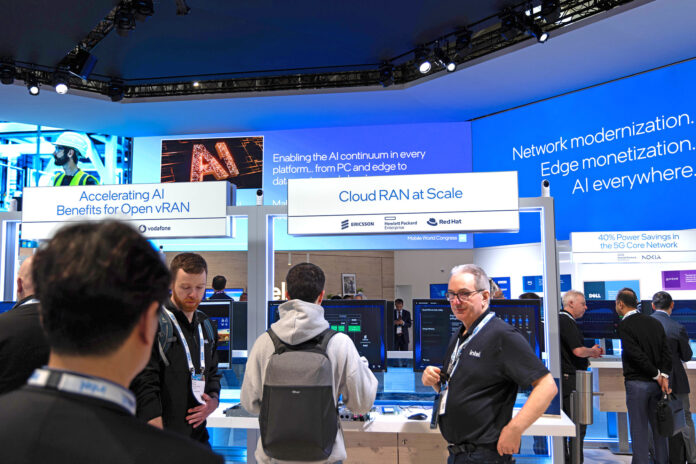With focuses from client to edge to RAN to core, Intel is all-in on AI for 5G
Mobile World Congress was big for Intel. In the larger sweep of 5G network disaggregation and automation, Intel has already built out a big partner ecosystem on its foundation of datacenter, radio and edge silicon. Now, with all eyes on artificial intelligence (AI), Intel used the annual confab in Barcelona to update on how its vision for “AI Everywhere” can bring together a number of telecoms challenges—automation, cloudification, disaggregation, virtualization, etc…—in service of total cost of ownership (TCO) reduction and more effective network monetization, all supercharged with AI.
Some of the standout news items:
- A future version of the 5G vRAN Xeon processor with built-in AI acceleration, Granite Rapids-D, is in first-call validation with partners.
- The company previewed Sierra Forest, an upcoming 5G core processor and noted “interest” from BT Group, Dell Technologies, Ericsson, HPE, KDDI, Lenovo and SK Telecom.
- At the enterprise edge, the company announced the Intel Edge Platform, “a modular and open software platform that enables enterprises to build, deploy, run, manage and scale edge and AI solutions on standard hardware with cloud-like simplicity.”
- Also for the core, Intel announced Infrastructure Power Manager software meant to reduce CPU power consumption for telco workloads. Partners referenced are Casa Systems, NEC, Nokia and Samsung.
- And all of this complements existing products and future roadmap of AI PCs using Intel chips.
Intel Network and Edge Group SVP and GM Sachin Katti said in a statement the company “is delivering innovations for our partners and their customers across network, edge and enterprises to modernize their networks, monetize new services at the edge, and bring AI everywhere. He said Intel’s silicon and ecosystem strategy “uniquely integrates general purpose compute and acceleration for networking, AI and vRAN workloads, and we are announcing market-leading next generation products for 5G core with Sierra Forest and 5G vRAN with Granite Rapids-D.”
For additional reference, Intel also is playing a role in AT&T’s massive $14 billion cloud RAN modernization deal with Ericsson to move 70% of its wireless traffic to “open-capable platforms by late 2026.” Ericsson, Fujitsu, Corning, Dell Technologies, and Intel are among publicly-named partners.
“What can AI do for the network? It’s unlimited.”
To better understand the big vision and the incremental steps, RCR Wireless News caught up with Cristina Rodriguez, vice president of the Network and Edge Group and general manager of the Wireless Access Network Division at Intel, ahead of MWC (and also at MWC).
“Obviously we know by now that AI is going to be everywhere from client, to edge, to our network, clouds, and it’s going to be accessible to all the workloads, including the RAN and the core in the mobile infrastructure,” Rodriguez said.
And good news for the industry, “The technology exists today,” she continued. “The industry has embraced a software-defined network end-to-end, open, virtualized…This is the first part of the vision—how do we have an architecture that can embrace flexibility, scalability, but especially innovation such as artificial intelligence.”
And the second part: “We have the CPUs today that can provide what is needed for that software-defined architecture. You can see right now we have Intel CPUs that can run the entire workload, not only the RAN workload, but also the AI inference workload that is needed in the network without having to use external components.”
To the TCO piece, this is all applicable around things like dynamic network configuration, traffic steering, inter-cell load balancing, energy efficiency, reduced power consumption, increased spectrum efficiency and network automation. For better network monetization, it’s all about network slicing. Big picture, “What can AI do for the network? It’s unlimited.”
For the full video interview with Rodriguez, check out the Telco AI Deep Dive: Intel on bringing AI into the RAN, also embedded below.

